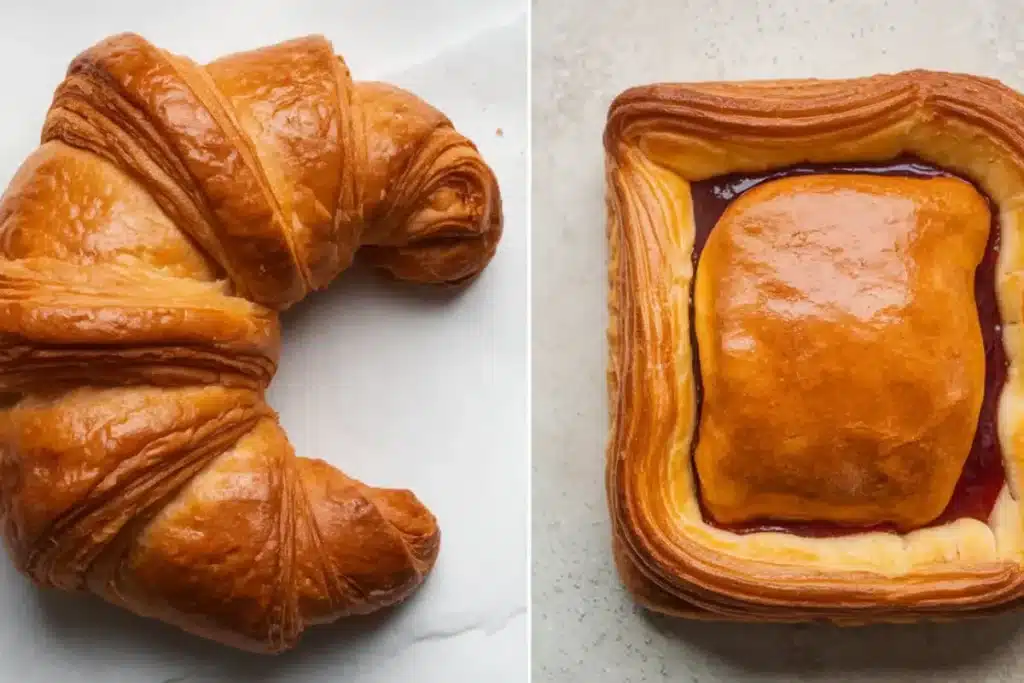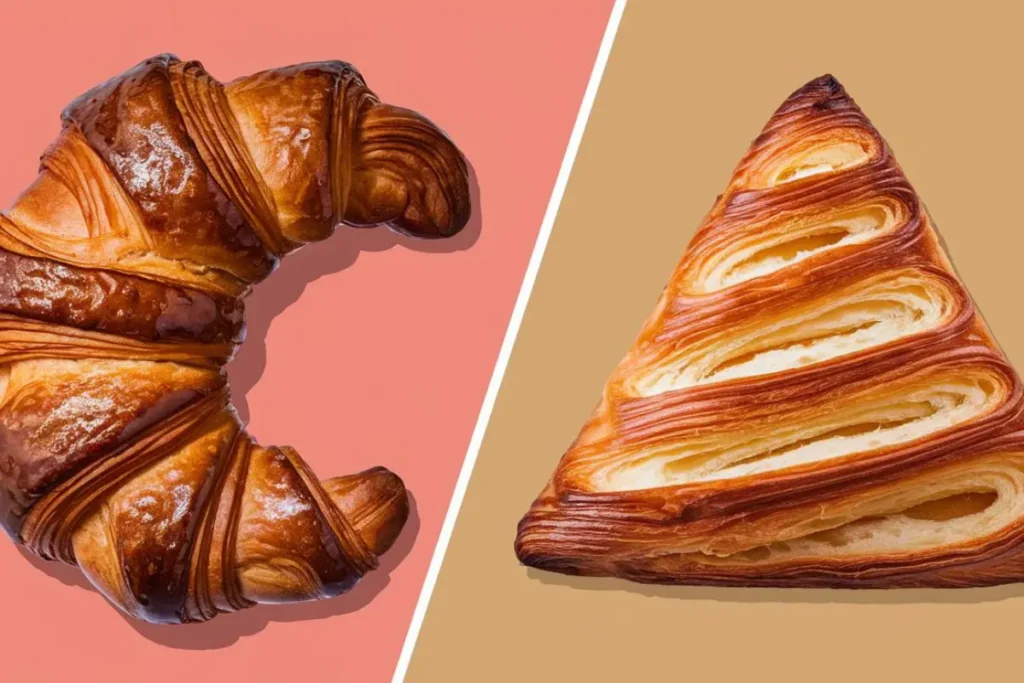Both the croissant and the gipfeli hold a special place in the hearts of pastry lovers. Despite their apparent similarities, these two pastries differ significantly. From their origins to their textures, and from their ingredients to their cultural significance, the difference between a croissant and a gipfeli offers insight into distinct culinary traditions. This article will explore these differences in detail, highlighting the unique characteristics that make each pastry special.
Historical Origins of Croissants
The croissant boasts a rich history, originating in Austria as the kipferl and evolving into the iconic French pastry we know today. In the 19th century, French bakers adapted the kipferl into the croissant by using laminated dough, which gives the pastry its signature flaky texture.
Austrian Roots of the Croissant
The kipferl emerged in Austria during the 13th century as a crescent-shaped pastry. It was simple in design, but its unique shape and delicious taste allowed it to spread across Europe.
French Evolution
French bakers perfected the croissant by introducing laminated dough, creating the flaky layers that define this beloved pastry. The French version is richer and more buttery, a staple in the country’s cuisine and breakfast culture.
Historical Origins of Gipfeli
The gipfeli, while less globally recognized, plays a significant role in Swiss culture. The name “gipfeli” comes from the Swiss German word for “little peak,” referring to the pastry’s pointed shape. The gipfeli likely originated in the 19th century and has since become a common feature in Swiss bakeries.
Swiss Tradition of the Gipfeli
The gipfeli enjoys a deep connection to Swiss culture and appears regularly at breakfast. It is often considered the Swiss answer to the French croissant, but with a unique twist in terms of ingredients and texture.
Understanding the Difference Between Croissant and Gipfeli Ingredients
The croissant and the gipfeli both utilize laminated dough, but they differ in their ingredients and preparation methods. These differences result in distinct textures and flavors.
Ingredients of Croissants
Croissants use high-fat butter, essential for creating their flaky layers. Bakers achieve the texture by rolling and folding the dough multiple times in a process known as lamination. This process contributes to the croissant’s rich, buttery flavor and light, airy texture.
Ingredients of Gipfeli
In contrast, bakers often use lower-fat butter or margarine for gipfelis, resulting in a denser texture. The lamination process is less extensive, which contributes to the gipfeli’s unique consistency. The result is a pastry that is heartier and more substantial than a croissant.
Table: Croissant vs Gipfeli Ingredients
| Ingredient | Croissant | Gipfeli |
|---|---|---|
| Butter | High-fat European-style butter | Lower-fat butter or margarine |
| Dough Texture | Light, flaky, and layered | Denser and slightly chewy |
| Lamination Process | Extensive, with multiple folds | Less extensive, fewer folds |
| Sugar Content | Typically higher, adding slight sweetness | Less sugar, resulting in a milder flavor |
How the Difference Between Croissant and Gipfeli Shapes Their Texture
 The croissant and the gipfeli offer contrasting textures that reflect their different ingredients and preparation methods. The croissant provides a light, flaky experience, while the gipfeli delivers a denser, chewier bite.
The croissant and the gipfeli offer contrasting textures that reflect their different ingredients and preparation methods. The croissant provides a light, flaky experience, while the gipfeli delivers a denser, chewier bite.
Croissant Texture Explained
The croissant’s texture comes from its multiple layers of dough and butter, which are rolled and folded to create a light, flaky structure that melts in the mouth. The process of laminating the dough with butter produces the distinctive layers and airy crumb that define a well-made croissant.
Gipfeli Texture Explained
The gipfeli has a denser, slightly chewy texture. It is still light but offers more resistance when you bite into it. The dough’s composition and the more compact lamination process result in a pastry that is satisfying and filling, with a heartier bite.
Exploring Croissant vs Gipfeli: Which Has the Better Flavor?
When it comes to flavor and aroma, both pastries offer distinct experiences that reflect their ingredients and preparation methods.
- Croissant Flavor: The croissant delights with a rich, buttery flavor and a subtle sweetness that enhances its flaky texture. Its aroma often fills bakeries with the inviting scent of warm butter.
- Gipfeli Flavor: The gipfeli provides a milder taste, with a more pronounced yeastiness and a slightly tangy aftertaste. It lacks the buttery richness of the croissant, offering a more neutral base that pairs well with various fillings.
Italic Key Point: While the croissant wins hearts with its indulgent butteriness, the gipfeli offers a more versatile, subtle flavor profile.
Difference Between Croissant and Gipfeli in Serving Suggestions
Both the croissant and the gipfeli are versatile pastries, suitable for various sweet and savory applications. These pastries offer a range of possibilities depending on how you choose to enjoy them.
Sweet vs. Savory Croissants
- Sweet Variations: Croissants pair well with jam or honey. For those with a sweet tooth, a chocolate croissant (pain au chocolat) or an almond croissant provides a richer experience.
- Savory Variations: For a more filling option, you can stuff croissants with ham and cheese, creating a hearty breakfast sandwich. Pairing a croissant with scrambled eggs and smoked salmon can elevate your brunch to a luxurious level.
Traditional and Modern Gipfeli
- Traditional Accompaniments: In Switzerland, gipfeli are commonly enjoyed with butter, honey, or cheese. They are often paired with coffee or hot chocolate for a classic Swiss breakfast experience.
- Regional Twists: Variations such as Schoggi-Gipfeli (chocolate-filled) and Laugen-Gipfeli (made with pretzel dough) offer unique takes on the classic gipfeli, catering to different tastes and preferences.
For a deeper dive into the specific differences between these pastries, you can explore more on the topic here.
Global Influence and Regional Variations of Croissant and Gipfeli
The croissant has spread far beyond its French origins, becoming a global icon. In contrast, the gipfeli remains a more localized favorite, with adaptations reflecting cultural preferences.
Croissants Around the World
The croissant has become a staple in many countries. In the United States, croissants often come filled with chocolate, almond paste, or ham and cheese. The cruffin, a croissant-muffin hybrid, also originated in the U.S., showcasing American creativity.
Japan offers unique flavors like matcha and azuki (red bean paste) in its croissants. Danish bakeries create wienerbrød, similar to croissants but often sweeter and filled with custard or marzipan. Italy’s cornetti resemble croissants but are softer and sweeter, often enjoyed with cappuccino.
In Latin America, medialunas—smaller, sweeter croissants—are popular, especially in Argentina and Uruguay. These are often glazed with syrup, giving them a shiny finish and sweet flavor.
Gipfeli Variations
While the gipfeli isn’t as internationally recognized as the croissant, it has similar cousins in neighboring countries. In Switzerland, you can find variations like the Schoggi-Gipfeli (chocolate-filled) or Laugen-Gipfeli (pretzel dough). These cater to both sweet and savory tastes.
In Germany, the butterhörnchen is similar to the gipfeli but softer and less dense. It often includes regional flavors like caraway or poppy seeds. Austria’s kipferl, the ancestor of both croissants and gipfeli, is more bread-like and less flaky. It often comes with fillings like nuts or chocolate.
Even within France, some regions offer their takes on gipfeli-style pastries, often incorporating local ingredients or shapes but staying true to the principles of lamination and butter-rich dough.
Cultural Significance and Popularity
The croissant’s global journey is a testament to its adaptability. Whether filled with custard in Denmark, glazed in Argentina, or paired with matcha in Japan, the croissant has proven to be an international pastry superstar. Its ability to integrate local flavors while maintaining its essential buttery, flaky nature has allowed it to thrive in diverse culinary environments.
On the other hand, the gipfeli remains a cherished but localized favorite, deeply rooted in Swiss culture. It reflects a different kind of appeal—one that values tradition, simplicity, and consistency. The gipfeli’s regional adaptations, while fewer in number, still offer a rich exploration of how local tastes influence traditional pastries.

FAQs
- Which pastry is healthier, croissants or gipfeli?
- Gipfeli are generally considered a lighter option due to their lower butter content, making them less calorie-dense than croissants.
- Can you make croissants and gipfeli at home?
- Yes, both can be made at home. However, croissants require more skill and time because of the lamination process.
- What is the best way to store croissants and gipfeli?
- Both pastries should be stored in an airtight container at room temperature for up to 2 days. They can also be frozen for longer storage.
- Which pastry is more popular in Switzerland?
- While croissants are popular, the gipfeli holds a special place in Swiss culture and is more commonly found in Swiss households and bakeries.
